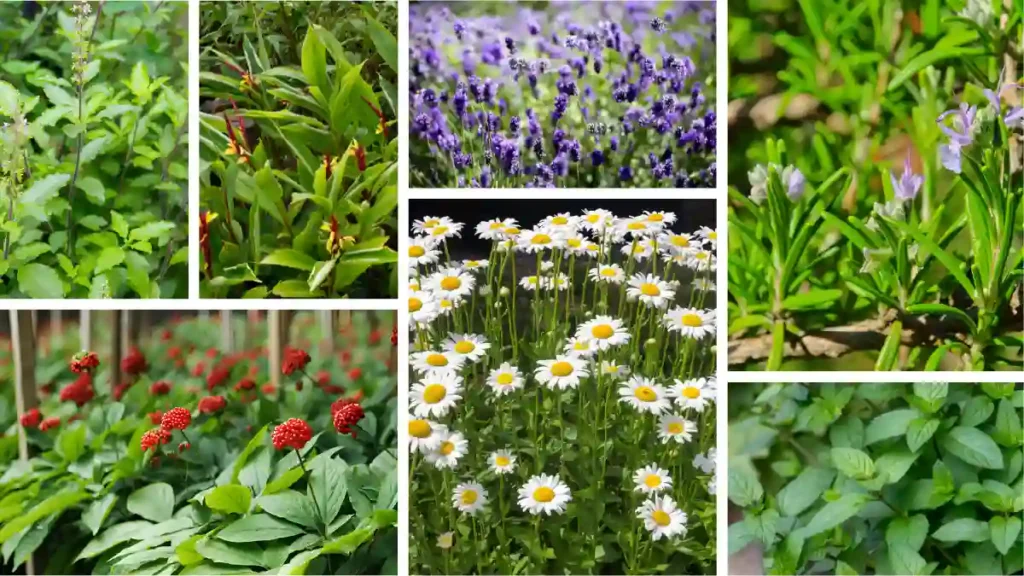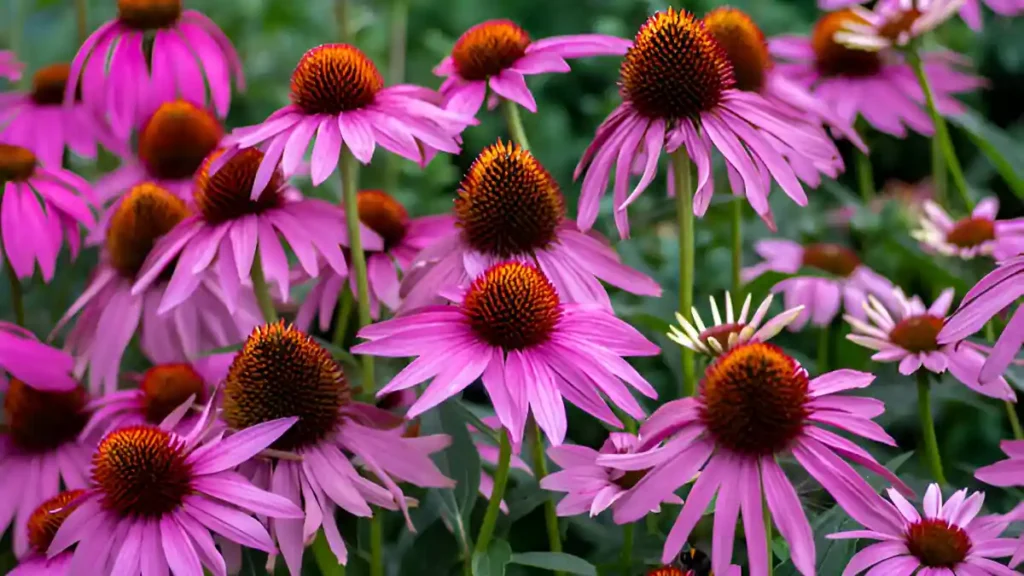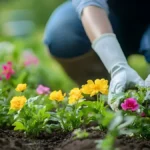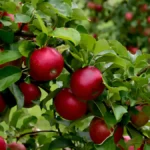Nature offers us an abundance of medicinal plants that have been used for millennia to treat a variety of maladies. Growing medicinal plants at home provides an abundance of natural cures for common ailments while beautifying your yard. Many of these plants are simple to grow and have been used for generations to promote health and wellness. We will look at ten potent medicinal plants that you may cultivate in your garden and their benefits and maintenance recommendations.
10 best medicinal plants:
1. Basil – The holy herb
The aromatic herb basil (Ocimum basilicum) has potent antibacterial, anti-inflammatory, and adaptogenic qualities. It works well for colds, coughs, and diabetes when given internally as a tea. Asthma, fevers, and intestinal system issues can all be treated internally using holy basil. Ringworm, insect stings, and other skin conditions can be treated using the plant’s juice.
Growing basil at home is simple.Plant in holes that are ¼ inch deep and in full light. Avoid overwatering, but keep the soil moist. To prevent flowering and the growth of more holy basil, harvest the plant before it flowers. This plant requires a lot of care because it keeps growing and blooming.
2. Ginger – The digestive tonic
Ginger, a natural cure for nausea, digestion, and pain relief, has been around for generations. It helps with motion sickness, muscle discomfort, and diabetes management. Make ginger tea for cold treatment and use fresh ginger in soups, stir-fries, and smoothies.
To grow ginger at home, place the rhizome in well-drained, loamy soil with buds facing upward, in a warm, humid place with shade. Keep the soil wet but not saturated. Ginger thrives above 70°F and requires occasional organic compost or fertilizer. Harvesting occurs after 8-10 months.
3. Peppermint – The natural pain reliever
Hikers chew peppermint while drinking from a stream to eliminate microorganisms. It’s an antibacterial medicinal plants, invigorating, choleretic, and antiseptic. Peppermint leaf tea is calming for colds, coughs, sore throats, gastrointestinal distress, headaches, and respiratory health.
Peppermint thrives in sunny, wet soil, producing more oils for medicinal efficacy. Despite its aggressive growth, it’s less invasive than some garden mints. Harvesting leaves and stems frequently before and during flowering promotes compact growth and maximizes its medicinal benefits.
4. Turmeric – The golden healer
Turmeric, which contains curcumin, is well-known for its anti-inflammatory and antioxidant qualities. It decreases inflammation, promotes brain function, and improves cardiovascular health by decreasing cholesterol and blood pressure. It can be mixed into drinks, soups, and curries.
To grow turmeric (Curcuma longa) at home, place a fresh rhizome in well-drained, fertile soil with the buds facing upward. Choose a warm, humid location with partial shade, as turmeric flourishes in temperatures over 70°F (21°C). Maintain regular soil moisture while avoiding waterlogging. For good growth, fertilize occasionally with organic compost. Turmeric takes 8-10 months to grow and can be harvested when the leaves turn yellow. Freshly obtained turmeric is ideal for both culinary and medicinal purposes.
5. Rosemary – Memory booster
Rosemary is high in antioxidants and anti-inflammatory chemicals, which help memory, cognitive function, digestion, and hair development.
Rosemary can be used both fresh and dried for cooking, herbal medicines, and aromatherapy. Its fragrant leaves enhance the flavor of roasted meats, vegetables, soups, and bread. As a medinical plants, rosemary tea can help digestion, improve memory, and reduce stress. The essential oil is used in aromatherapy to promote relaxation and scalp health. Fresh sprigs can also be steeped in oils or vinegar to enhance their flavor and health benefits.
To grow rosemary at home, place it in well-drained soil in a sunny location with 6-8 hours of direct sunlight. Water sparingly, as rosemary is drought-tolerant. Regular pruning promotes bushy growth and fragrant leaves for culinary and medicinal purposes.

6. Chamomile – The sleep enhancer
Chamomile, recognized for its relaxing qualities, is used to improve sleep quality, reduce inflammation, and alleviate menstrual cramps. Newborn diaper rash has been treated with an essential oil derived from chamomile flowers. It can be used to aid sleep by drinking chamomile tea before bed and applying chamomile oil to alleviate tension.
Plant chamomile seeds or cuttings in the spring. You can grow chamomile indoors or outdoors, but only in areas with partial shade to full sun. Chamomile does not require much water, so the soil should be somewhat dry.
7. Lavender – The stress reliever
Lavender, a powerful herbal treatment, is known for its calming and anti-inflammatory effects. It relieves tension, promotes sleep, and soothes skin irritations, making it useful for treating acne, eczema, and burns. Use lavender essential oil to promote relaxation and sleep.
To grow lavender from seed or cuttings at home, plant in well-drained, sandy soil in a sunny area with at least 6-8 hours of direct sunlight every day. Lavender thrives in warm, dry climates and is drought-tolerant once planted. Water carefully, allowing the soil to dry in between waterings, and avoid overwatering to prevent root rot. Prune lavender periodically to promote bushy growth and more flowers.
8. Echinacea – The immune booster
As a medicinal plants Echinacea is a popular herbal medicine for increasing immunity and fighting colds, as well as offering anti-inflammatory benefits and alleviating cold symptoms. It can be ingested as tea or as supplements for more effects.
Plant Echinacea (Echinacea purpurea) in well-drained soil in a sunny spot, as it thrives in direct sunlight. Once established, this hardy perennial is drought tolerant and requires little water. Sow seeds or plant seedlings in early spring, spacing them 12-18 inches apart. Regular deadheading produces additional flowers, while periodic pruning helps keep its shape.
9. Ginseng – The energy enhancer
Ginseng, an adaptogenic herb, increases energy and mental clarity, helping to manage fatigue, improve brain function, and control diabetes. It can be taken as a supplement or in tea.
Plant seeds or roots of Panax ginseng or Panax quinquefolius in well-drained, fertile soil with lots of organic matter. Ginseng grows in dark, forest-like environments with cold temperatures and high humidity. Keep the soil moist but not soggy, and be patient because ginseng takes several years to mature. Mulching preserves moisture and protects the roots.
10. Ashwagandha – The adaptogenic herb
Ashwagandha, an ancient medical herb, promotes stress management and overall well-being by lowering anxiety, increasing testosterone and fertility, and improving physical performance. It can be included in supplements or smoothies.
To cultivate ashwagandha (Withania somnifera) at home, sow seeds in well-drained, sandy soil in a warm, sunny spot. This drought-tolerant herb thrives in arid circumstances and requires little water. It grows best at temperatures ranging from 70 to 95°F (21 to 35°C) and matures in 5-6 months. Harvest the roots when the plant’s leaves start to dry out.
Conclusion:
Keeping these top 10 medicinal plants at home means that you always have access to natural solutions for common health issues. These plants offer several benefits when utilized as teas, essential oils, or directly. Start your herbal garden today and experience nature’s healing power!
Certainly! If you’d like to learn more, please consider following our WhatsApp Channel, Facebook, Instagram, YouTube, Twitter, and Pinterest.
A frequently asked questions:
Q1: How many are medicinal plants?
A1: Over 50,000 medicinal plants are used worldwide in both traditional and modern medicine. Some well-known examples include Aloe vera, which is used to cure the skin, and Tulsi (Holy Basil), which has antimicrobial characteristics.
Q2: What is called medicinal plant?
A2: A medical plant is one that has natural ingredients that can help prevent, treat, or cure ailments. Its components (flowers, leaves, roots, stems, fruits, or seeds) are used directly or in some form as medicine to cure a condition or disease.
Q3: Who is the father of medicinal plants?
A3: Hippocrates, the ancient Greek physician, is widely regarded as the “Father of Medicine” due to his use of medicinal herbs in therapy. However, Pedanius Dioscorides, a Greek botanist and physician, is known as the “Father of Medicinal Plants” because of his work De Materia Medica, which chronicled hundreds of medicinal herbs.
Q4: What is the oldest medicinal plants?
A4: The oldest known medicinal plants include Aloe vera, which is used for skin and wound healing, and Ephedra, which is used in traditional Chinese medicine to treat respiratory problems. These plants have been utilized for thousands of years, with records going back to ancient Egypt, China, and Mesopotamia.



